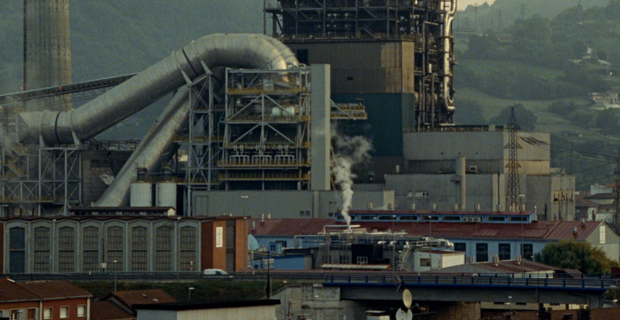Review: Work, or to Whom Does the World Belong (2019)

To whom actually the world (or at least the fruits of someone’s work) belongs is one of two eternal questions asked in Elisa Cepedal’s debut feature-length documentary Work, or to Whom Does the World Belong. The other question, who will change the world, is posed in a film within the documentary in its centrepiece passage. The mentioned filmed, framed elegantly within the actual screening, is Slatan Dudow’s Kuhle Wampe or Who Owns the World (1932), written by Bertolt Brecht. The titles are similar, the topics are closely related, and one can argue that the reality of today is not too dissimilar to that of the 30s.
Work, or to Whom Does the World Belong premiered last year at Gijon. On its festival tour it played at Sheffield Doc/Fest and is currently showing at Doclisboa, where we caught it.
The film is set in the Spanish region of Asturia, geographically separated from the rest of the country by high mountain ranges, and known for its coal mines that served as the motor of the industrial development on the regional and national level. The miners, most of whom came from other parts of the country, were also the pioneers in fighting for better work rights and conditions. The history of the class struggle in that area is rich and even bloody, but the concept of de-industrialization might be too much of challenge for the miners. Many already left as they were made redundant, the rest are under constant threats from the market and political decisions. Can they make a final fight in the times that are changing?
Although she is from the area, Elisa Cepedal adopts a bit of a cold approach to the subject, signalled early on in the opening, rotating panoramic shots by the film’s DoP and executive producer Daniel Chaytor. Once the geography is established, the film runs on two parallel tracks. One is a prolonged historical lesson served through the narration by Tom Wandrag, sometimes illustrated with the various archive material. The other is a close observation of the citizens of Cepedal’s home town Barredos in their daily activities: the children go to school, the adults to work, shopping, housework and entertainment is also being done. The two lines melt into one towards the end, when Cepedal takes us to a workers’ meeting where the new measures and tactics regarding the fight for their jobs are discussed.
The studious approach remains in place for the most of the film, but it would be wrong to say that Cepedal is cold towards her subjects. She just tries to understand them and their fight over the course of history and nowadays. By inserting Dudow’s film based on Brecht’s thoughts, she demonstrates her passion for the workers’ rights and the fight for a more just world. Also filming the whole thing on the actual film tape in a boxy 4:3 aspect ratio is not just practical decision (it is easier to blend the archival material in it), or an artistic statement (we are witnessing the revival of both the Academy image format and the filming on stock), but it also infuses the film with some much needed organic warmth, making Work, or to Whom Does the World Belong as passionate as it is thorough.
Original title: El trabajo o a quién le pertence el mundo
Year: 2019
Runtime: 65 minutes
Countries: Spain, UK
Languages: English, Spanish, German
Directed by: Elisa Cepedal
Written by: Elisa Cepedal
Narrated by: Tom Wandrag
Cinematography by: Daniel Chaytor
Editing by: Elisa Cepedal
Sound by: Toni de Benito
Production design by: Carmen Vázquez Fuentes
Costume design by: Carmen Vázquez Fuentes
Visual effects by: Tom Wandrag
Colourist: Daniel Chaytor
Assistant directors: Maria Cardena de Haro, Mar Moreno González
Produced by: Aída Gaitero Fernández
Executive producers: Marta Fernández Crestelo, Daniel Chaytor
Production companies: Chaytor Industries, Freews
















